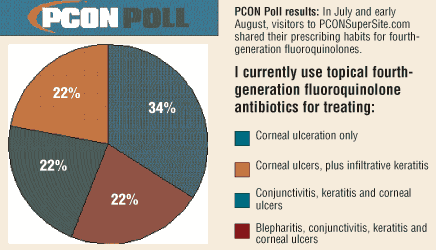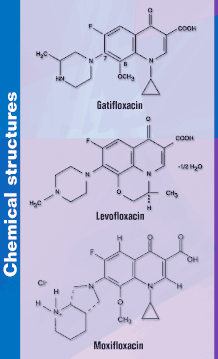For ocular infection, fourth-generation fluoroquinolones are the clear choice
Since their approval by the Food and Drug Administration in 2003, fourth-generation fluoroquinolones have quickly assumed a prominent place in the optometric armamentarium. Especially valuable for their broad-spectrum coverage against gram-positive and gram-negative organisms, these agents have become the anti-infective of choice for many optometrists.
“Optometry has always been a profession that embraces new technology, new treatments and new medications,” said Marc Bloomenstein, OD, FAAO, a practitioner at Barnet Dulaney Perkins Eye Center, Phoenix. “Our prescribing rights are relatively new, so we want to prescribe what is going to be the strongest, fastest and safest for our patients.”
Currently, two fourth-generation fluoroquinolones are on the market: Alcon’s Vigamox (0.5% moxifloxacin ophthalmic solution) and Allergan’s Zymar (0.3% gatifloxacin ophthalmic solution). Both are FDA approved for treating bacterial conjunctivitis.
Recent statistical data
According to Jane Wolf, senior product manager for Zymar, the use of fourth-generation fluoroquinolones has increased rapidly in both optometry and ophthalmology.
“I think it is amazing that since these drugs were approved a little over a year ago, the market has transitioned rapidly over to the fourth-generation fluoroquinolones,” she told Primary Care Optometry News. “This is a credit to the doctors who are innovative and not afraid to try something new. But it also points to some of the resistance that was growing with the third-generation fluoroquinolones. Doctors were motivated to go to a better anti-infective.”

According to Alcon spokesman Seph Jensen, fourth-generation fluoroquinolones are quickly becoming first-line therapy for the treatment of bacterial conjunctivitis.
“Many physicians struggle with the inability to culture such eye infections; therefore, they are switching to fourth-generations for superior gram-positive and equal gram-negative coverage,” Mr. Jensen said in an interview. “The goal of every physician is to get his or her patients back to daily life as quickly as possible.”
This goal is most effectively met through the use of fourth-generation fluoroquinolones, Mr. Jensen added. “Fluoroquinolones are the best option for the treatment of bacterial conjunctivitis and are becoming the choice for first-line therapy,” he said.
Ms. Wolf cited year-to-date data for May 2004, showing the increased use of fourth-generation fluoroquinolones. “If you look just at fluoroquinolones within eyecare, third-generation fluoroquinolones make up 20% of all fluoroquinolones prescribed year-to-date through May,” she said. “So then 80% is already fourth-generation.”
Looking at all anti-infectives prescribed by optometry and ophthalmology, year-to-date through May 2004, Ms. Wolf said, 73% of these drugs are fluoroquinolones. She added that 58% are fourth-generation fluoroquinolones. “Third-generation fluoroquinolone prescriptions have reduced significantly,” she said. “And then, to a much lesser extent, you have agents such as aminoglycosides and polymyxin B.”
Ms. Wolf narrowed the statistics down to the prescribing rate of optometry. “If you look just at the anti-infectives prescribed by optometry, 43% of those are fourth-generation fluoroquinolones,” she said.
Current prescribing habits
While fourth-generation fluoroquinolones are currently FDA approved for bacterial conjunctivitis only, these agents are being prescribed for many other conditions.
“Many of our local surgeons have switched to the fourth-generation medications in surgical prophylaxis and postoperative therapy,” said Anthony B. Litwak, OD, FAAO, a practitioner at Veterans Administration Medical Center in Baltimore. “I would choose a fourth-generation fluoroquinolone in suspected gram-positive conjunctivitis or keratitis.”
Dr. Bloomenstein said he would definitely reach for a fourth-generation fluoroquinolone for surgical prophylaxis. “I think there is a medicolegal issue to not use a fourth-generation fluoroquinolone when you are talking about surgical prophylaxis,” he said. “If you are not using a medication that can penetrate therapeutically into the eye and eradicate bugs across the whole spectrum, then you are not giving your patients the best care.”
Dr. Bloomenstein said fourth-generation fluoroquinolones are ultimately his antibiotic of choice. “From the first day they were approved, I went into my cabinet and removed all of the samples of third-generation fluoroquinolones,” he said. “It has completely changed my whole thought process and moved it toward fourth-generation.”
According to Bruce E. Onofrey, OD, RPh, FAAO, chair of primary care eye services at Lovelace Medical Center, Montgomery Eye Clinic, Albuquerque, fourth-generation fluoroquinolones are also excellent for postoperative cataract surgery patients.
“We use a fourth-generation fluoroquinolone in all postop cataract cases,” he told Primary Care Optometry News. “We also use it for all bacterial keratitis cases and in the majority of bacterial conjunctivitis cases.”
Resistance to third-generation agents
One very compelling reason for prescribing fourth-generation fluoroquinolones is the increased resistance to third-generation fluoroquinolones.
“The rate of resistance to antibiotics is increasing alarmingly,” said William Townsend, OD, a practitioner at Advanced Eye Care in Canyon, Texas, and a consultant at the VAMC in Amarillo. “Even gram-negative bacteria are developing resistance to virtually all of the older antibiotics, including the second- and third-generation fluoroquinolones. We have begun to rely heavily on the fourth-generation meds for all bacterial infections and for our pre- and postoperative prophylaxis.”
Dr. Townsend explained that there are two ways to prevent bacteria from becoming resistant to a given antibiotic. One way is simply not to prescribe the antibiotic, he said. “That is obviously not an option. In eye care, we have little impact on the total exposure of any given bacterial strain to a given antibiotic,” he said in an interview. “It has been estimated that while a patient is being treated for severe bacterial gastrointestinal disease, more bacteria are exposed to the antibiotic than in all the cataract cases performed in the United States in 1 year.”
Another option is to effectively kill the offending organism, he said. “Dead bacteria do not mutate,” he said. “So, by using appropriate dosing of fourth-generation fluoroquinolones, we are virtually ensuring that the offending organisms will all be destroyed.”
Dr. Townsend said two important enzymatic processes are undermined by fluoroquinolones. DNA gyrase and topoisomerase IV are the two type II topoisomerases present in bacteria.
“Though clearly related, based on amino acid sequence similarity, they each play crucial, but distinct, roles in the cell,” he said. “DNA gyrase is involved primarily in supporting nascent chain elongation during replication of the chromosome, whereas topoisomerase IV separates the topologically linked daughter chromosomes during the terminal stage of DNA replication.”
Dr. Townsend said older fluoroquinolones primarily target the first enzyme and, to a much lesser extent, the second.
“It requires a single mutation to effectively neutralize the effect of these antibiotics,” he said. “Fourth-generation fluoroquinolones target both enzymatic steps, and, thus, resistance can only develop when a double mutation occurs. This is the primary reason resistance to these medications is minimal.”
Formulary and fluoroquinolones
|
|
For practitioners working in a Veterans’ Administration (VA) setting, the use of fluoroquinolones may be limited by formulary. Due to limited budgetary resources, some of these facilities stipulate that a less expensive third-generation fluoroquinolone must be used prior to prescribing a fourth-generation fluoroquinolone.
“The process of adding a new medication to the formulary at the VA can be an arduous task,” Dr. Litwak said. “The committee must review the advantages and disadvantages, safety, comparisons with current medications and cost.”
Dr. Litwak said that while many local surgeons have switched to the fourth-generation medications in surgical prophylaxis and postoperative therapy, his hospital still uses third-generation fluoroquinolones for other types of infection.
“We still treat central, sight-threatening corneal ulcers with fortified antibiotics (cephazolin and tobramycin) after obtaining corneal cultures,” he said. “In suspected Pseudomonas corneal ulcers, we will treat with third-generation fluoroquinolones.”
Dr. Onofrey said his formulary committee has selected a fourth-generation agent to add to its list. “We are on a formulary; therefore, we selected a specific agent to add to our limited list of agents,” he said.
Dr. Bloomenstein said he is not restricted by formulary when choosing an antibiotic for his patients. “Some patients will have their insurance companies send me a form asking me to switch them to a generic or to other medications on their formulary,” he said. “I explain to the patients why we are using this medication and why it is more expensive to them. Which is more expensive: to have a sight-threatening infection or a medication that is going to help that?”
Dr. Litwak said fourth-generation fluoroquinolones are quickly becoming an indispensable tool for fighting ocular infection. “The fourth-generation fluoroquinolones fill a void in our topical antibiotic therapy in the coverage of gram-positive organisms,” he said. “Many of our older antibiotics (gentamicin, tobramycin) have developed resistance to gram-positive organisms, and our third-generation fluoroquinolones, although excellent for gram-negative organisms, do not possess good gram-positive coverage.”
Dr. Litwak said these drugs are likely to become an important part of any optometric practice. “The optometric community should welcome the fourth-generation fluoroquinolones into their armamentarium for anterior infections,” he said. “They are excellent medications for suspected gram-positive infections and for surgical prophylaxis. With further clinical experience and studies, they may replace our standard fortified therapy for central corneal ulcers.”
Iquix: a new concentration
In March 2004, Santen Pharmaceuti-cals (Osaka, Japan) received FDA approval for a new ocular anti-infective, Iquix (levofloxacin ophthalmic solution 1.5%), indicated for the treatment of bacterial corneal ulcers. According to a company press release, Iquix is a sterile topical ophthalmic solution containing 1.5% levofloxacin.
“A corneal ulcer is potentially sight threatening due to its residual scarring,” said Richard L. Lindstrom, MD, of Minnesota Eye Consultants, in the press release. “Iquix’s high concentration has positive implications for the treatment of ulcers.”
For Your Information:
- Marc Bloomenstein, OD, FAAO, can be reached at Barnet Dulaney Perkins Eye Center, 4800 N. 22nd St., Phoenix, AZ 85016; (602) 955-1000; fax: (602) 508-4744; e-mail: Mbloomenstein@BDPEC.com. Dr. Bloomenstein has no direct financial interest in the products mentioned in this article, nor is he a paid consultant for any companies mentioned.
- Jane Wolf is senior product manager for Zymar. She can be reached at Allergan Inc., PO Box 19534, Irvine, CA 92623; (714) 246-4500; fax: (714) 246-4971.
- Seph Jensen is senior pharmaceutical project manager at Alcon Labs Inc. He can be reached at Alcon Laboratories, 6201 South Freeway, Fort Worth, TX 76134; (817) 551-8529; fax: (817) 551-4426.
- Anthony B. Litwak, OD, FAAO, can be reached at 10 N. Greene St., Baltimore, MD 21201; (410) 605-7230; fax: (410) 605-7232. Dr. Litwak has no direct financial interest in the products mentioned in this article, nor is he a paid consultant for any companies mentioned.
- Bruce E. Onofrey, OD, RPh, FAAO, can be reached at 5150 Journal Center Blvd. NE, Albuquerque, NM 87109; (505) 897-7057; fax: (505) 262-3366; e-mail: eyedoc3@aol.com. Dr. Onofrey has no direct financial interest in the products mentioned in this article, nor is he a paid consultant for any companies mentioned.
- William Townsend, OD, can be reached at 1801 4th Avenue, Canyon, TX 79015; (806) 655-7748; fax: (806) 655-2871; e-mail: drbill1@cox.net. Dr. Townsend has no direct financial interest in the products mentioned in this article, nor is he a paid consultant for any companies mentioned.
- Richard L. Lindstrom, MD, can be reached at Park Avenue Medical Office Bldg., Suite 106, 706 East 2nd St., Minneapolis, MN 55404; (612) 813-3633; fax: (612) 813-3660. Dr. Lindstrom has no direct financial interest in the products mentioned in this article. He is a paid consultant for Santen.
- PCON Poll results: In July and early August, visitors to PCONSuperSite.com shared their prescribing habits for fourth-generation fluoroquinolones.

